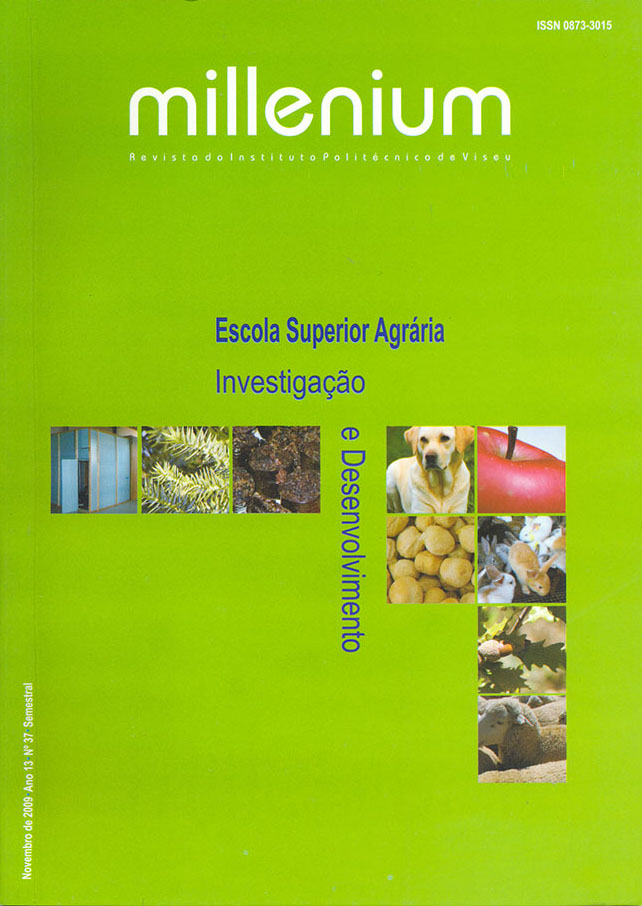Aplicação da econometria espacial às culturas agrícolas permanentes portuguesas
Resumo
A consideração de efeitos espaciais é cada vez mais frequente e para
isso contribuiu, entre outros, o trabalho de Anselin (1988). Neste estudo analisase,
através de métodos de estimação “cross-section”, a influência dos efeitos
espaciais nas culturas agrícolas permanentes das NUTs III de Portugal
Continental, com base nos dados do Recenseamento Geral da Agricultura de
1999, considerando a relação de Verdoorn como base de estudo. Pela análise dos
dados (considerando a estatística Moran´s I) e dos resultados das estimações
(tendo em conta as componentes “spatial lag” e “spatial error”) constata-se que
haverá autocorrelação espacial positiva, sobretudo nos frutos secos e na vinha.
Downloads
Referências
• ABREU, M.; Groot, H.; and Florax, R. (2004). Spatial Patterns of Technology Diffusion: An Empirical Analysis Using TFP.
ERSA Conference, Porto.
• ANSELIN, L. (1988). Spatial Econometrics: Methods and Models. Kluwer Academic Publishers, Dordrecht, Netherlands.
• ANSELIN, L. (1995). Local Indicators of Spatial Association-LISA. Geographical Analysis, 27, pp: 93-115.
• ANSELIN, L. (2001). Spatial Econometrics. In: Baltagi (eds). A Companion to Theoretical Econometrics. Oxford, Basil
Blackwell.
• ANSELIN, L. (2002a). Spatial Externalities. Working Paper, Sal, Agecon, Uiuc.
• ANSELIN, L. (2002b). Properties of Tests for Spatial Error Components. Working Paper, Sal, Agecon, Uiuc.
• ANSELIN, L. (2002c). Spatial Externalities, Spatial Multipliers and Spatial Econometrics. Working Paper, Sal, Agecon, Uiuc.
• ANSELIN, L. (2002d). Under the Hood. Issues in the Specification and Interpretation of Spatial Regression Models. Working
Paper, Sal, Agecon, Uiuc.
• ANSELIN, L. (2003a). An Introduction to Spatial Autocorrelation Analysis with GeoDa. Sal, Agecon, Uiuc.
• ANSELIN, L. (2003b). GeoDaTM 0.9 User’s Guide. Sal, Agecon, Uiuc.
• ANSELIN, L. (2004). GeoDaTM 0.9.5-i Release Notes. Sal, Agecon, Uiuc.
• ANSELIN, L.; Bera A.K.; Florax, R.; and Yoon, M.J. (1996). Simple Diagnostic Tests for Spatial Dependence. Regional Science
and Urban Economics, 26, pp: 77-104.
• ANSELIN, L. and Bera, A. (1998). Spatial Dependence in Linear Regression Models with an Introduction to Spatial
Econometrics. In: A. Ullah and D. Giles (eds), Handbook of Applied Economic Statistics, New York: Marcel Dekker.
• ANSELIN, L.; Bongiovanni, R.; and Lowenberg-DeBoer, J. (2001). A Spatial Econometric Approach to the Economics of Site-
Specific Nitrogen Management in Corn Production. Working Paper, Sal, Agecon, Uiuc.
• ARBIA, G. and Piras, G. (2004). Convergence in per-capita GDP across European regions using panel data models extended to
spatial autocorrelation effects. ERSA Conference, Porto.
• ARMSTRONG, H. (1995). Convergence Among Regions of the European Union, 1950-1990. Papers in Regional Science: The
Journal of the RSAI, Vol. 74,2, pp. 143-152.
• BALTAGI, B.H.; Song, S.H.; and Koh, W. (2003). Testing panel data regression models with spatial error correlation. Journal of
Econometrics, 117, pp: 123-150.
• BARRO, R. and Sala-i-Martin, X. (1991). Convergence across states and regions. Brooking Papers on Economic Activity, 1, pp:
-107.
• BERA, A. and Yoon, M. (1993). Specification testing with locally misspecified alternatives. Econometric Theory, 9, pp: 649-658.
• BERNAT, Jr., G.A. (1996). Does manufacturing matter ? A spatial econometric view of Kaldor’s laws. Journal of Regional
Science, Vol. 36, 3, pp. 463-477.
• FINGLETON, B. (1999). Economic geography with spatial econometrics: a “third way” to analyse economic development and
“equilibrium” with application to the EU regions. EUI Working Paper ECO nº 99/21.
• FINGLETON, B. (2001). Equilibrium and Economic Growth: Spatial Econometric Models and Simulations. Journal of Regional
Science, 41, pp: 117-147.
• FINGLETON, B. and McCombie, J.S.L. (1998). Increasing returns and economic growth: some evidence for manufacturing from
the European Union regions. Oxford Economic Papers, 50, pp. 89-105.
• FLORAX, R.J.G.M.; Folmer, H.; and Rey, S.J. (2003). Specification searches in spatial econometrics: the relevance of Hendry´s
methodology. ERSA Conference, Porto.
• HANSON, G. (1998). Market Potential, Increasing Returns, and Geographic concentration. Working Paper, NBER, Cambridge.
• KALDOR, N. (1966). Causes of the Slow Rate of Economics of the UK. An Inaugural Lecture. Cambridge: Cambridge University
Press.
• KALDOR, N. (1967). Strategic factors in economic development. Cornell University, Itaca.
• KELEJIAN, H.H. and Robinson, D.P. (1995). Spatial correlation: A suggested alternative to the autoregressive models. In:
Anselin, L. and Florax, R.J. (eds). New Directions in Spatial Econometrics. Springer-Verlag, Berlin.
• KIM, C.W. ; Phipps, T.T. ; and Anselin, L. (2001). Measuring the Benefits of Air Quality Improvement: A Spatial Hedonic
Approach. Working Paper, Sal, Agecon, Uiuc.
• LONGHI, S. ; Nijkamp, P ; and Poot, J. (2004). Spatial Heterogeneity and the Wage Curve Revisited. ERSA Conference, Porto.
• LUNDBERG, J. (2004). Using Spatial Econometrics to Analyze Local Growth in Sweden. ERSA Conference, Porto.
• MESSNER, S.F. and Anselin L. (2002). Spatial Analyses of Homicide with Areal data. Working Paper, Sal, Agecon, Uiuc.
• PAELINCK, J.H.P. (2000). On aggregation in spatial econometric modelling. Journal of Geographical Systems, 2, pp: 157-165.
• SANDBERG, K. (2004). Growth of GRP in Chinese Provinces : A Test for Spatial Spillovers. ERSA Conference, Porto.
• VERDOORN, P.J. (1949). Fattori che Regolano lo Sviluppo Della Produttivita del Lavoro. L´Industria, 1, pp: 3-10.
Downloads
Publicado
Como Citar
Edição
Secção
Licença
Os autores que submetem propostas para esta revista concordam com os seguintes termos:
a) Os artigos são publicados segundo a licença Licença Creative Commons (CC BY 4.0), conformando regime open-access, sem qualquer custo para o autor ou para o leitor;
b) Os autores conservam os direitos de autor e concedem à revista o direito de primeira publicação, permitindo-se a partilha livre do trabalho, desde que seja corretamente atribuída a autoria e publicação inicial nesta revista.
c) Os autores têm autorização para assumir contratos adicionais separadamente, para distribuição não-exclusiva da versão do trabalho publicada nesta revista (ex.: publicar em repositório institucional ou como capítulo de livro), com reconhecimento de autoria e publicação inicial nesta revista.
d) Os autores têm permissão e são estimulados a publicar e distribuir o seu trabalho online (ex.: em repositórios institucionais ou na sua página pessoal) já que isso pode gerar alterações produtivas, bem como aumentar o impacto e a citação do trabalho publica
Documentos necessários à submissão
Template do artigo (formato editável)





